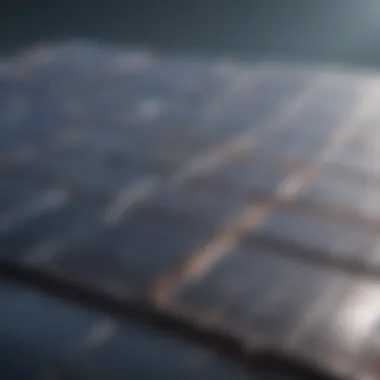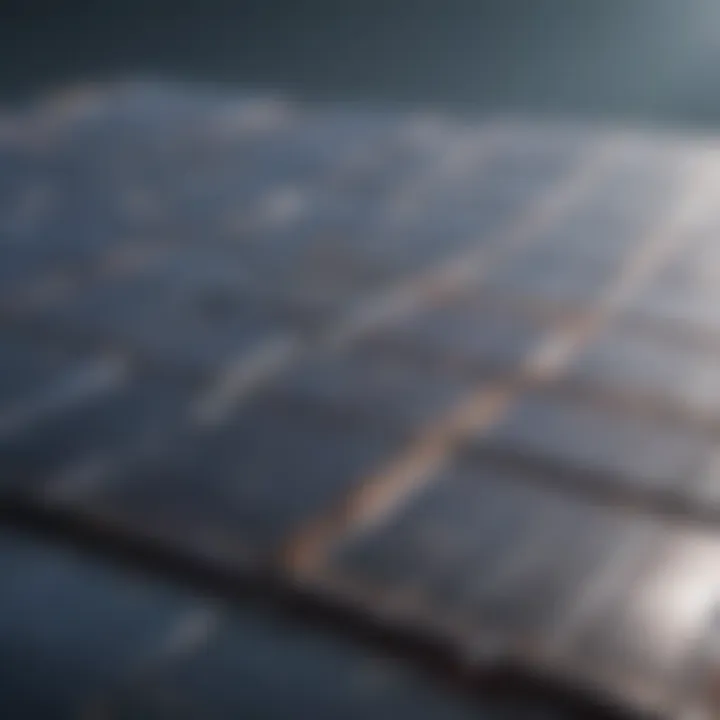Understanding Solar Panel Photovoltaic Cells


Intro
The demand for renewable energy sources is increasing globally. Solar energy plays a crucial role in this transformation. Understanding the mechanisms behind solar panel photovoltaic cells is vital. This knowledge provides insight into their applications and the future trends within the industry.
Photovoltaic technology converts sunlight directly into electricity. This process not only supports energy needs but also advances sustainability efforts. Different designs and technologies of photovoltaic cells exist, each with unique efficiencies and applications. The exploration of these factors will help position solar energy more prominently in the energy landscape.
Research Context
Background and Rationale
The global energy crisis and climate change compel the need for cleaner energy solutions. Photovoltaic cells emerge as a suitable technology, providing an alternative to fossil fuels. They reduce reliance on non-renewable resources, contributing to a more sustainable energy matrix.
The rationale for exploring solar panel technologies is evident. Economic implications, technological advancements, and environmental impact shape public and corporate interest. Additionally, this topic maintains relevance in academic, industrial, and policy-making discussions.
Literature Review
Numerous studies highlight the importance of photovoltaic technology. Research illustrates the evolution of solar cell efficiency over the years. Publications from sources like Wikipedia and Britannica offer comprehensive insights into cell design and energy conversion efficiencies. Recent advancements, particularly in perovskite solar cells, demonstrate significant potential for the future.
Emerging trends indicate a shift towards integration with smart grid systems and energy storage solutions, providing enhanced energy management. Several researchers discuss how these advancements will enable better resource utilization and reduce costs.
With this foundational knowledge established, the subsequent sections will delve deeper into the mechanics and future prospects of photovoltaic cells. Understanding their operation, applications, and ongoing developments will help stakeholders make informed decisions about solar energy adoption.
Preamble to Solar Energy
Solar energy is becoming increasingly vital in the contemporary fight against climate change and the quest for sustainable energy solutions. It harnesses light from the sun, converting it into usable power for various applications. This section introduces the fundamental principles surrounding solar energy, its historical background, and its significance as a renewable energy source.
What is Solar Energy?
Solar energy refers to the radiant energy produced by the sun, which can be captured and converted into forms of energy that are usable by humans. This energy is accessible in two main formats: thermal and photovoltaic. Thermal energy converts sunlight into heat, used for heating water or spaces, while photovoltaic energy directly converts sunlight into electricity using specialized cells. The simplicity of harnessing this energy lies in the sun's abundance and reliability—it is a resource that is available daily and can be accessed in most locations worldwide.
History of Solar Energy Utilization
The use of solar energy dates back centuries, but significant advancements have taken place in the last century. Early instances involved simple solar thermal collectors for heating water. In the 1830s, scientists discovered that certain materials produced electricity when exposed to light, laying the groundwork for photovoltaic technology. Fast forward to the 1950s when the first practical photovoltaic cell was created, which made solar energy a feasible option for power generation. Since then, developments in technology have led to increased efficiency and affordability of solar panels, making them widely adopted in both residential and commercial settings.
Importance of Renewable Energy
Renewable energy is crucial for several reasons. Firstly, it significantly reduces reliance on finite fossil fuels, which contribute to pollution and climate change. Solar energy, as a sustainable source, offers the chance to produce clean power while minimizing environmental degradation. Secondly, solar energy can play a vital role in energy independence for countries around the world. By harnessing local solar resources, nations can reduce their vulnerability to energy price fluctuations and geopolitical tensions. Furthermore, the solar energy industry creates jobs and stimulates economic growth, contributing to a more sustainable future. The transition to solar energy represents not just a technical shift, but also a fundamental change in how society can interact with its energy needs.
Fundamentals of Photovoltaic Cells
Photovoltaic cells are the backbone of solar energy technology. Their function in converting sunlight into electrical energy is critical for harnessing solar power. Understanding their fundamentals is essential for anyone interested in solar technology. This section covers how photovoltaic cells work, the different types available, and their key components. This knowledge helps us appreciate the advantages and challenges of solar energy.
How Photovoltaic Cells Work
Photovoltaic cells, often referred to as solar cells, generate electricity through the photovoltaic effect. This process occurs when photons from sunlight strike the cell, exciting electrons, and creating an electric current. The key material used in these cells is usually silicon. When silicon is doped with certain impurities, it becomes either positively charged (p-type) or negatively charged (n-type). This interaction at the junction of these two types creates an electric field. When sunlight hits this region, electrons flow, generating electric power. The simplicity of this mechanism is a significant reason photovoltaic technology is widely adopted.
Types of Photovoltaic Cells
Different types of photovoltaic cells exist, each with unique features and applications.
Monocrystalline Photovoltaic Cells
Monocrystalline photovoltaic cells are known for their efficiency and space-saving abilities. They are made from a single crystal structure of silicon. This uniform structure allows for minimal electron movement resistance, making them highly efficient in converting sunlight into energy. This type of cell is often recognized by its dark black color and rounded edges.
The primary benefit of monocrystalline cells is their efficiency, typically ranging from 15% to 22%. However, they are more expensive to manufacture than other types, which can influence overall costs for solar projects.
Polycrystalline Photovoltaic Cells
Polycrystalline photovoltaic cells are another common type. They are made from silicon crystals that are melted together, resulting in a less uniform structure than monocrystalline cells. This manufacturing process is cheaper, which translates to lower costs for the consumer.
Despite being more affordable, the efficiency of polycrystalline cells is usually lower, around 13% to 16%. Their bluish hue and square appearance set them apart visually. While they may require more space to achieve the same power output as monocrystalline cells, they still effectively contribute to solar energy systems.
Thin-Film Photovoltaic Cells
Thin-film photovoltaic cells are unique in their production. They are created by depositing thin layers of photovoltaic material onto a substrate, which can be glass, plastic, or metal. This technology allows for flexible applications and lightweight designs.


The advantage of thin-film cells lies in their versatility and lower production costs. However, their efficiency is quite lower, generally ranging between 10% and 12%. They might not be the best option for limited space installations but offer unique benefits for specific applications such as building-integrated photovoltaics.
Key Components of Solar Panels
Solar panels consist of various components that work together to convert solar energy into electricity. Each part plays a vital role in optimizing the performance and reliability of photovoltaic technology.
Solar Cells
As the core component, solar cells convert sunlight into electricity. The efficiency of the system largely depends on the type and quality of solar cells used. Selecting high-quality solar cells can lead to better performance and a higher return on investment over time.
Encapsulant
The encapsulant protects solar cells from environmental factors like moisture and dirt. Typically made of a polymer material, it also allows sunlight to reach the solar cells effectively. The durability and transparency of encapsulants are essential for maintaining the lifespan and efficiency of solar panels.
Backsheet
The backsheet is the rear layer of the solar panel. It provides insulation and protection against environmental elements. Made from durable materials, the backsheet ensures the safety and integrity of solar cells over their operational life. Its role is critical in enhancing panel longevity.
Glass Layer
The glass layer covers the front of solar panels, providing protection from the harsh environmental conditions. High-transparency tempered glass is often used because it allows maximum sunlight to pass through while being durable against impacts and weather. This layer is essential for maintaining cell performance and reliability.
Efficiency and Performance Factors
Efficiency and performance factors are central to the discussion of photovoltaic cells and their impact on solar energy systems. The efficiency of solar panels directly affects energy production, making it a crucial element for both homeowners and large-scale solar energy developments. Furthermore, understanding these factors gives insights into where improvements can be made, allowing for enhanced system reliability and sustainability.
Measuring Photovoltaic Efficiency
Photovoltaic efficiency refers to the ability of solar panels to convert sunlight into usable electrical energy. This metric is essential in assessing the performance of solar energy systems. The efficiency of a solar panel is calculated as the ratio of the electrical output to the solar energy incident on the panel over a specific period.
To accurately evaluate efficiency, standardized testing conditions are used, often referred to as Standard Test Conditions (STC). Under STC, panels are tested at 25 degrees Celsius, with an irradiance level of 1000 W/m² and under a spectrum of AM 1.5. This benchmarking helps in comparing the performance of different solar panel types, thus guiding consumers and investors in their purchase decisions. Higher efficiency translates into more energy output from a given area, leading to better space utilization, especially in urban settings.
Factors Affecting Efficiency
Several factors influence the efficiency of solar panels. Understanding these implications helps in optimizing performance and maximizing energy generation.
Temperature
Temperature plays a significant role in the efficiency of photovoltaic cells. As temperature increases, the efficiency of these cells typically decreases. This is because higher thermal conditions can aggravate the recombination of charge carriers within the solar cell, leading to reduced voltage output. The key characteristic here is that while photovoltaic cells convert sunlight into electricity, excessive heat can hinder this process.
In articles about solar technology, it is beneficial to highlight this aspect as it urges users to consider the installation locations and conditions for their solar panels. Choosing panels designed to perform better at higher temperatures can mitigate efficiency losses. Some modern photovoltaic technologies even incorporate materials designed to cope with thermal strain, which is an essential feature for areas with high ambient temperatures.
Angle of Sunlight
The angle at which sunlight strikes the solar panels is another critical factor affecting efficiency. Panels perform optimally when sunlight strikes their surface perpendicularly. The key characteristic of this angle is that it is often variable throughout the day and across seasons. This variability necessitates strategic mounting solutions, such as adjustable racks or tracking systems, aiming to maximize exposure to direct sunlight.
The unique feature of optimizing the angle of sunlight is the potential benefit it brings in increased energy yield. However, the disadvantage lies in the additional complexity and costs associated with tracking systems, which may not be feasible for all installations. Evaluating whether the improved yields justify these costs is an important consideration for anyone engaging with solar energy.
Shading
Shading can significantly affect the performance of photovoltaic cells by blocking sunlight from reaching parts of the panel. This obstruction reduces the overall efficiency and energy output. The key characteristic of shading is that it can be caused by surrounding structures or vegetation, and even light clouds can impact performance. This makes shading an often-overlooked aspect of solar panel placement and installation.
The unique advantage of awareness about shading is that it prompts users to consider their installation environment carefully. In some cases, it may even warrant the integration of microinverters or power optimizers to minimize losses from shaded areas. However, if not managed well, shading can lead to excessive energy losses, making it a critical topic for discussion in solar energy applications.
Advancements in Efficiency Technology
Technological advancements continue to evolve the landscape of photovoltaic efficiency. Research into materials and designs aims to create more efficient cells that can generate energy in a wider array of conditions. Innovations such as bifacial solar panels, which capture sunlight from both sides, and transparent solar cells that can double as windows, are noteworthy developments improving overall system performance. Additionally, improvements in manufacturing processes are reducing costs and increasing availability, making solar energy more accessible than ever.
"With ongoing research and development, the future of photovoltaic technology holds significant promise in reducing costs and enhancing efficiency, making solar energy an increasingly viable alternative for global energy needs."
The pursuit of higher efficiency not only benefits energy output but also encourages a broader acceptance of renewable energy solutions in both residential and commercial applications.
Applications of Photovoltaic Technology
The applications of photovoltaic technology are crucial for addressing current energy needs while promoting sustainability. As the world confronts the challenges of climate change, solar energy stands out due to its versatility and potential in various sectors. Exploring these applications is vital to understand how they contribute to both residential and commercial environments. Each application offers distinct benefits that can help reduce energy costs and carbon footprints.


Residential Solar Energy Systems
Residential solar energy systems represent one of the most widespread implementations of photovoltaic technology. Homeowners can install solar panels on rooftops to harness solar energy, which converts sunlight directly into electricity. This setup not only provides clean energy but also reduces reliance on grid power, yielding significant savings on utility bills. Furthermore, many governments offer incentives that can offset installation costs, making this option more accessible.
The advantages of residential systems include:
- Energy independence: Homeowners can generate their own power.
- Increased property value: Homes with solar installations often see a rise in market value.
- Sustainability: Using solar energy contributes to lower greenhouse gas emissions.
Despite these benefits, the initial costs and space considerations can be barriers. Homeowners must assess their roof's orientation and shading, as these factors influence system performance.
Commercial and Industrial Uses
Photovoltaic technology has significant applications in commercial and industrial settings. Businesses can utilize solar panels to power operations, decrease electricity costs, and enhance their environmental credentials. For industries such as manufacturing, using solar energy can translate to substantial energy savings, especially in high-consumption environments.
Key points for businesses to consider include:
- Scalability: Solar systems can be designed to meet the specific energy demands of industries.
- Corporate Social Responsibility: Adopting solar technology aligns with corporate sustainability goals.
- Long-term investments: Although installation can be expensive, the potential return on investment over years is considerable.
Moreover, commercial installations can often take advantage of larger roof surfaces, allowing for extensive energy generation compared to residential systems.
Solar Farms and Utility-Scale Systems
Large-scale solar farms employ photovoltaic technology to generate substantial amounts of electricity for the grid. These installations help meet energy demands on a broader scale and are often located in areas with optimal sunlight exposure. Utility-scale solar energy can significantly contribute to regional energy security while facilitating the transition to renewable sources.
Considerations surrounding solar farms include:
- Land use: Siting these farms requires careful planning to minimize impacts on local ecosystems.
- Grid integration: Ensuring that the generated power is effectively delivered to consumers necessitates infrastructure investment.
- Regulatory factors: Developers must comply with environmental regulations, which can vary by location.
Economic Considerations
Economic considerations are vital when discussing solar panel photovoltaic cells. This aspect encompasses multiple dimensions, including costs, incentives, and market dynamics. Understanding these factors is essential for making informed decisions about adopting solar technology. With the price of traditional energy sources rising, the shift to renewable energy becomes economically appealing. Economic factors often dictate the feasibility and accessibility of solar energy, influencing how households and businesses view solar panel installation.
Cost Analysis of Solar Systems
The cost analysis of solar systems involves multiple components. Initially, the cost of purchasing solar panels drives the investment decision. Costs vary based on factors such as the type of photovoltaic cells used and installation requirements.
- Equipment Costs: The main component is the solar panels themselves. In general, monocrystalline panels are more expensive than polycrystalline ones. Additionally, thin-film options may also present lower costs but often yield less efficiency.
- Installation Costs: Labor and engineering costs can substantially impact overall expenses. Installing solar systems involves structural considerations, including roof conditions and local regulations.
- Maintenance Costs: Although solar panels require minimal maintenance, there may still be periodic expenses. Cleaning panels or replacing inverters can add to lifecycle costs.
Understanding these financial elements can help in budgeting for solar energy projects effectively.
Incentives and Subsidies
Numerous incentives are available to encourage the adoption of solar energy. Governments and private sectors provide these financial aids to offset installation costs and stimulate market growth.
- Tax Credits: Many jurisdictions offer tax incentives for solar installations. The federal solar tax credit, also known as the Investment Tax Credit (ITC), allows homeowners to deduct a percentage of the costs from their taxes.
- Rebates: Local and state programs may offer rebates directly reducing initial expenses, making solar systems more affordable.
- Financing Options: Innovative financing models allow consumers to install solar systems with little or no upfront costs. Power Purchase Agreements (PPAs) and solar leases provide alternative pathways for accessing solar energy.
These incentives enhance the economic attractiveness of solar adoption, leading to wider utilization.
Market Trends in Solar Industry
Market trends play a crucial role in shaping the future of solar energy. Understanding these dynamics allows stakeholders to anticipate changes and adapt accordingly.
- Growth in Demand: As sustainability becomes a priority, the demand for solar technologies is on the rise. This growth is observed in residential, commercial, and utility-scale sectors, highlighting the expanding interest in solar solutions.
- Technological Advancements: Continuous improvements in photovoltaic technology lead to increased efficiency and reduced costs, making solar more attractive.
- Global Partnerships: International collaborations and investments are driving down costs and expanding access to solar technology in developing regions.
Keeping track of these trends is essential for investors and consumers alike, allowing them to maximize benefits and understand future risks in the solar market.
For more information on solar energy and its economic implications, visit Wikipedia, Britannica, or check out discussions on Reddit about energy trends or incentives.
Environmental Impact of Photovoltaic Cells
The environmental impact of photovoltaic cells is a key subject in the discussion of solar energy systems. Understanding this impact involves looking at various aspects such as the life cycle of solar panels, waste management practices, and the comparative advantages they hold over traditional energy forms. As the planet grapples with climate change and resource depletion, photovoltaic cells present a significant opportunity to lessen our ecological footprint. This section aims to provide a thorough analysis of the environmental implications of these technologies.
Life Cycle Assessment of Solar Panels
A life cycle assessment (LCA) analyzes a product's environmental impact from cradle to grave. In the case of solar panels, this assessment includes several stages: extraction of raw materials, manufacturing, installation, operation, and disposal or recycling. Each of these stages has its own environmental implications.


- Raw Material Extraction: Photovoltaic cells predominantly use silicon, which is derived from sand. The extraction process can cause habitat disruption and requires energy. Additionally, other materials, like silver and cadmium, are often involved in cell production, leading to concerns about sourcing practices.
- Manufacturing: The energy-intensive manufacturing phase is a significant contributor to the carbon footprint of solar panels. Efforts to reduce energy use in factories and switch to renewable power sources during this phase are essential.
- Installation and Operation: Once installed, solar panels produce energy without emissions. Their operational life generally lasts 25 years or more with minimal environmental impact, contributing positively to energy sustainability.
- Disposal: The end-of-life stage is critical. If not disposed of or recycled properly, solar panels may become waste. Proper disposal methods and recycling processes can mitigate adverse impacts significantly.
Conducting an LCA helps to identify these impacts clearly and provides guidance on mitigating them throughout the solar panel's life cycle.
Recycling and Waste Management
Recycling solar panels is essential for minimizing environmental harm. When photovoltaic cells reach the end of their usable life, appropriate recycling methods can recover valuable materials such as silicon, silver, and glass. Innovative recycling technologies are emerging to process these components efficiently, making the recycling process more effective and economically viable.
- Current Recycling Challenges: Despite the benefits, recycling rates for solar panels remain low compared to other electronic waste. Methods to improve collection systems and create incentives for recycling are necessary.
- Policy Frameworks: Establishing regulations that mandate recycling processes for solar panels can enhance sustainability. Legislation can provide a framework that encourages manufacturers to consider end-of-life management as part of the design process.
- Consumer Awareness: Increasing consumer knowledge about proper disposal and recycling of solar panels can also play an important role in mitigating their environmental impact.
Comparative Environmental Advantages
The environmental advantages of photovoltaic cells make them a prominent alternative to fossil fuels. A few of these benefits include:
- Reduced Greenhouse Gas Emissions: Solar panels generate energy without emitting carbon dioxide during operation. This significant reduction in greenhouse gases contributes to climate change mitigation.
- Lower Water Consumption: Unlike traditional energy sources, particularly coal and nuclear power, solar energy requires minimal water during operation. This characteristic is crucial in areas facing water scarcity.
- Sustainable Energy Source: As long as the sun shines, solar power continues to be available, making it a reliable energy source without subject to the depletion concerns associated with fossil fuels.
Future Trends in Photovoltaic Technology
The future of photovoltaic technology stands as a pillar of imminent advancements in solar energy. Understanding these trends is essential for both industry experts and those newly entering the field. It can shed light on the direction of energy solutions and reveal opportunities for innovation. This section examines several critical areas of development, including emerging technologies, integration with smart grids, and the accompanying challenges and opportunities.
Emerging Innovative Technologies
Innovation in photovoltaic technology revolves around making solar energy more efficient and accessible. One critical trend is the development of bifacial solar panels. These panels capture sunlight on both sides, increasing efficiency by reflecting light from surfaces like snow or water.
Perovskite solar cells also gain attention. These cells have the potential for high efficiency and lower production costs compared to traditional silicon-based cells. Researchers explore options to improve stability and longevity, which currently limit their commercial use.
Building-integrated photovoltaics (BIPV) are also significant. These systems integrate solar energy solutions into building materials, turning rooftops, windows, and walls into energy-generating surfaces. This not only optimizes space but also enhances the aesthetic appeal of buildings.
"The architectural integration of solar technology leads to a more sustainable urban environment."
Furthermore, transparent solar panels are being developed, which could allow for energy generation without obstructing the view. Efforts to improve energy storage systems, such as lithium-sulfur and solid-state batteries, are crucial to nocturnal energy consumption, improving overall energy efficiency.
Integration with Smart Grid Solutions
The evolution of smart grid technology enhances the management of solar energy systems. Smart grids use digital communication to optimize electricity flow. This synergy promotes better communication between consumers, producers, and energy management systems.
The integration of solar energy into smart grids allows for real-time monitoring of energy production and consumption. This adaptability leads to a more resilient grid system, reducing the risks of outages and making better use of renewable resources. With the growth of electric vehicles, smart grids can manage vehicle-to-grid technology, where electric cars can act as mobile storage units, thus adding to grid stability.
Adopting advanced forecasting analytics also allows grid operators to predict solar energy production based on weather conditions. Optimizing energy distribution actively mitigates reliance on fossil fuels, enhancing sustainability.
Challenges and Opportunities
As photovoltaic technology develops, it does not come without hurdles. One major challenge is the intermittency of solar energy. While solar panels generate energy during the day, there may be insufficient supply during periods of low sunlight or high demand. Therefore, enhancing energy storage solutions and creating strategic partnerships with traditional energy sources is vital.
Supply chain issues related to raw materials also present challenges. As the demand for solar panels grows, ensuring a consistent and sustainable supply of materials like silicon, silver, and rare earth elements is critical. This scenario demands innovation in recycling techniques and alternative material research to alleviate resource shortages.
Despite these challenges, there are vast opportunities. A global push for renewable energy creates an environment ripe for investment and innovation. Policymakers are increasingly favoring incentives for solar technology adoption. Additionally, consumer awareness grows regarding the benefits of clean energy, paving the way for expanded market penetration.
Ending and Recommendations
In examining the intricate workings of photovoltaic cells, this article underscores the significance of understanding solar technology in the broader context of energy solutions. Photovoltaic cells are pivotal in harnessing renewable energy, potentially reducing dependence on fossil fuels. As climate change accelerates, the adoption of solar energy systems becomes critical for sustainability. The innovations discussed reflect not only advancements in efficiency and cost-effectiveness but also their increasing integration into our energy infrastructure.
Summary of Findings
Solar panel technology has made significant strides in recent years. Key findings include:
- Efficiency Gains: Continuous improvements in the efficiency of photovoltaic cells have been observed, with new materials and designs leading to better energy production.
- Economic Viability: With decreasing costs and various governmental incentives, solar energy is becoming an appealing option for residential, commercial, and industrial users.
- Environmental Benefits: Life cycle assessments indicate a positive environmental impact associated with solar energy compared to conventional energy sources, highlighting benefits in terms of emissions and resource utilization.
"The advancements in photovoltaic technology present a remarkable opportunity to reshape our energy landscape, making it more sustainable and resilient."
Recommendations for Adoption
For stakeholders looking to adopt solar technology, several recommendations can enhance the effectiveness and return on investment:
- Conduct Feasibility Studies: Before installation, consider a detailed analysis of solar potential in your area, along with economic assessments.
- Invest in Quality Components: Selecting high-quality solar panels and inverters is crucial for maximizing energy production and system longevity.
- Stay Informed on Incentives: Utilize available subsidies and incentives offered by governments to lower initial investment costs and improve overall project viability.
- Incorporate Smart Technologies: Integrate solar systems with smart grid technologies to optimize energy usage and improve grid resilience.
Call for Further Research
Research plays a crucial role in advancing solar technology. Future studies should consider:
- Long-Term Performance: Evaluation of solar panel performance over extended periods under various environmental conditions.
- Recycling Technologies: Development of more efficient recycling processes for end-of-life solar panels to minimize waste and enhance sustainability.
- Policy Impacts: Investigating the effects of different policy frameworks on solar adoption rates to identify best practices that encourage investment in renewable energy.



